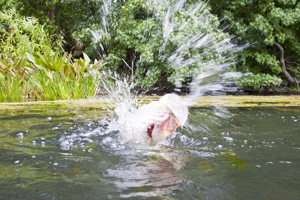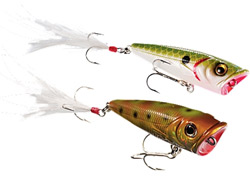
If I had to choose one style of bait that consistently provokes heart-stopping excitement, thunderous thrills and a fair share of big bass to boot, it would be no other than a topwater lure. There's something about the way these plugs and prop baits sputter and weave across the surface of the water, filling an angler with anticipation while they patiently await the churning of water and splash of that next big strike. Fishing really doesn't get any better than this.
Understanding what to use and when to throw it is the most important part of the topwater game. Follow this guide and enjoy the fruits of your labor this upcoming season.
Fishing With Buzzbaits
This inline bait is made up of a thin wire or titanium shaft, a skirted hook and metal or plastic blades. It is these blades that provide lift to the lure, and allow it to sputter and gurgle along the surface of the water. Although the wake and sound this lure produces ultimately triggers the hit, it is the skirted hook that fish key in on and hit. Due to this upturned hook design, the buzzbait is predominantly weedless when fished under most conditions. Because of this benefit, throwing these lures into the thick jungle of snags and weeds that Mr. Largemouth calls home, is advisable and expected. Some of my favorite areas to toss buzzbaits are across open flats, adjacent to and through pad beds, stump fields and laydowns, dock areas, and of course, shoreline structure.
 |
| Seeing bass explode on topwater baits always gets an angler's heart pounding. |
One trick to remember when tossing buzzbaits is to start your retrieve the moment your lure hits the water, and maintain a steady cadence in order to keep your lure buoyant and on the surface of the water.
Poppers Poppers, also known as chuggers, feature a concave head design, which displace water and create "popping" sounds when jerked or manipulated with the rod. Some of the more notable members of this family are the Rebel Pop-R, XCalibur Pop'n Image and the XPS Z-Pop.
Most of these lures feature a hand-tied bucktail, or rubber skirt on the rear hook, which gives added flash and enticement. The belief is that these lures mimic a wounded minnow, or frog, splashing on the surface. Whatever the case, these lures provide explosive strikes, and with the new hooks on the market, ensure a solid hook set. The loud popping noise calls in fish from afar, and largemouth love to smack these baits with a thunderous crash.
Due to their exposed hooks, open water that is free of weed congestion is your best bet. They are dynamite when worked adjacent to docks, through wood and laydowns and along the perimeter of pad beds and weedlines. Although they are generally thought of as "calm water" baits, throwing them during wind and waves can also illicit heart-stopping strikes.
Fishing With Prop Baits
 |
| The loud popping noise calls in fish from afar, and largemouth love to smack these baits with a thunderous crash. |
Prop baits are cigar shaped lures that have either one, or two propellers affixed to the front or back of the plug, or both. These cylindrical lures sputter and splash, creating a surface commotion when retrieved and providing a visual and audible focus for a fish to key in on. Some of the more noteworthy models on the market are the Heddon Tiny and Heddon Baby Torpedo fishing bait, and the Smithwick Devil's Horse.
Similar in many respects to the Popper family, prop baits can be used in any open water areas that largemouth call home. Although I rely on these baits primarily during early morning and evening periods, I have also found them to be effective during hot weather periods, especially when fish are in ambush mode and tight to cover. They have also proved useful during rainy and overcast days, especially when fish are putting on the feedbag.
Prop baits can either be used with a straight retrieve, which creates a constant trail of bubbles and sound, or in a "stop and go" manner. If the fish are in an overly aggressive mood, a straight retrieve would undoubtedly be your best bet. Let the fish dictate what they want, and change your technique to suit their needs. As with all surface baits, experimentation is often the key to fruitful days on the water.
"Cigar-Style" Fishing Baits
The type of lures which fall into this category have no action of their own, and it is up to the angler to manipulate and work the bait, in order to give it the desired action. This technique is called "walking the dog" and is achieved by constantly twitching the rod, with pauses in between, which creates a zigzag pattern with the lure. The most notable of this family are the Heddon Zara Spook, Super Spook and Puppy, XPS Slim Dog and the Strike King Spit-N-Image. Largemouth bass absolutely love these baits, and will clobber them when put in front of their face. Generally used as a shallow water presentation, they are an excellent search bait when working your way through flats or along shoreline areas.
Keep a constant cadence to your technique, which will allow your bait to exhibit the alluring side-to-side action that fish can't refuse. Although the technique of "walking the dog" may take some time to perfect, the results will be well worth the effort.
Fishing With Plastic Frog and Creature Baits
 |
| Generally used as a shallow water presentation, creature baits such as frogs are an excellent search bait when working your way through flats or along shoreline areas. |
This is one of my favorite types of fishing - shallow water, heavy cover and a Scum Frog on the end of the line. Plastic frog style baits are big bass producers, mimicking the natural prey of Mr. Largemouth to a "T." Bass will hit these baits hard, smashing through vegetation with a Kamikaze-type approach.
Frog baits are built with a buoyant body, with weedless and upturned hooks that are virtually snag-free. When a fish hits, the body of the bait collapses, allowing the hooks to penetrate the bony jaw.
Toss these lures wherever bass may lurk — pad beds, slop, cane and thick weed flats. I like to work them in a "stop and go" manner (much like a real frog would move), paying careful attention to pause my lure in any open pockets I may come across. These pockets are where a large percentage of strikes will occur, namely because the fish can make visual sight with the lure.
Never set the hook on the initial strike. Although it may seem appropriate to do so, it will usually end up with a lure flying back at the angler full steam. Wait a second or two for the fish to turn with your lure before setting the hook. This extra wait will result in many more fish to the boat. And when it is time, set that hook hard.
10 Topwater Fishing Tips
Follow these rules to help land more fish this coming season:
- Use high quality hooks on all of your baits. Chemically sharpened is the way to go.
- Fish topwaters throughout the day, not only during "prime times."
- Experiment with your retrieve to discover what the fish want.
- Baits with rattles can help call fish in, especially during murky water conditions.
- Natural colored baits are good bets during clear water fishing.
- Cold fronts and topwaters are usually a low percentage style of fishing.
- Topwaters during the midnight hour can account for big bass.
- Learn to proficiently use all types of topwater baits. This will allow you to cover all of the bases when out on the water.
- Superlines and topwaters make an excellent team. These no stretch lines allow for easier hook sets, especially on long casts.
- Concentrate on cover — largemouth will usually be close by.
- 38920 views

